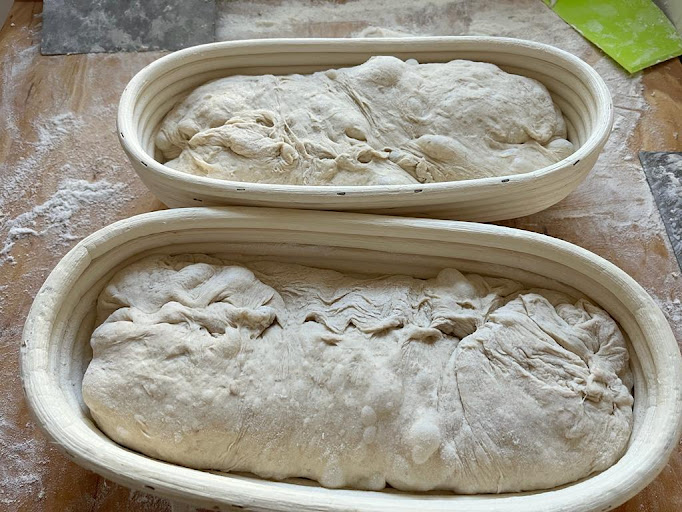Pain au Levain - BC20 style
Welcome to another step-by-step recipe from BreadClub20. Why not drop by our main Facebook page by clicking here.... If you like what you see and enjoy the recipe, we hope you go on to join us by 'Liking' and 'Subscribing'.
Here's a quandary. When is a sourdough not a sourdough?
We're used to baking sourdough over a three-day period.
Day One is prepping the sourdough 'starter' or levain.
Day Two is for making the dough - mixing, stretching, folding, stretching, folding, coil folding, laminating, preshaping, resting, shaping and finally putting to bed for at least twelve hours in a cold refrigerator.
Day Three is for baking.
But, what if we wanted a lovely French-style loaf with all the attributes of sourdough but....produced in one day?
We'd need to incorporate quite a few French-style baking techniques but we could 'adopt' more of a yeasted approach even though we were using a traditional sourdough 'starter'.
Combine the two and achieve the best of both worlds.
And that's what we're building here in our Pain au Levain - BC20 style.
Firstly, of course, we need a FORMULA
A note about the flour.
Ideally, we'd use T65 French flour. This is a high-gluten flour, suitable for baguettes or artisan bread.
It's often called E650 flour or Tipo 1 Italian flour.
To make it easier, look for bread flour that has a protein content of about 11% - 12%.
Here in the UK, this brings me into the realm of what I call 'supermarket flour'. It's not a high protein 13.5%+ very strong bread flour that I'd acquire from a specialist miller, but it's a similar flour to the French T65.
In the US, King Arthur all-purpose flour comes in at 11.7% protein.
NOTE - I always bake two loaves at a time to maximise the oven space.
The formula below is for ONE loaf.
500 gms strong bread flour (11% protein)
340 gms tepid water
100 gms active starter (levain)
10 gms crushed sea salt
For those of you who work in Bakers' Percentages
Total flour : 550 gms = 100%
Total water : 390 gms = 70.9%
Total salt : 10 gms = 2&
Total levain : 20%
Phew! 20% that's a lot of levain....well, yes...but we're planning to make and bake this loaf on the same day. I'm not expecting to sit and wait for the gluten to develop over a long time. It's all about cracking on with it and seeing the loaf arrive on the same day.
METHOD
1. Take a large bowl and add the tepid water. Then add the starter and mix thoroughly.
3. Cover and rest in a warm place for 30 minutes.
4. Add the salt. Incorporate thoroughly and bring together, kneading by hand, for no more than half a minute. Cover and leave to rest for ONE hour.
if you find the dough sticks to the board or to your hands, try misting the board with water and also your hands. It'll make life a lot easier.
What's a 'warm place'.....somewhere as near to 24⁰C as you can achieve. No cooler than 21⁰C, if you can and no warmer than 26⁰C.
24⁰C is the optimum temperature for good sourdough levain action.
6. Tip the dough out gently onto a non-floured board. Knead gently for about 20 seconds. Place back in the bowl, cover and leave in your warm place for TWO hours.
7. Rice flour your work surface. Tip the dough out gently and shape it gently into a boule or batard. Cover with a cloth and leave in a warm place to rest for 15 minutes.
.jpeg) |
| Remember, I'm making TWO loaves. |
.jpeg) |
| I use a piece of linen to cover my loaves while they rest. |
8. Reshape and gently move the batard/boule around the work surface to build up surface tension on the dough. Work to build up a decent amount of surface tension on the 'skin' of the dough. Prepare a banneton that is large enough to take the dough and leaves enough space to allow it to expand a little over the next hour.
Cover the banneton and leave it in a warm place for between 30 - 60 minutes or until the dough has expanded sufficiently.
It'll take less time in a warm place and longer in a cooler room.
9. Now, place the banneton in a plastic bag in the freezer for the time it takes to preheat a Dutch Oven (or equivalent) to 240⁰C. Chilling the dough will make it easier to score with a razor blade. If your oven takes forever to heat up, chill in the refrigerator instead. Chill it down until it's firm and easy to handle.
10. Once the oven is up to temperature, remove the dough from the freezer. Turn the dough out onto parchment paper or a silicone sling. Score with a razor and transfer the dough to the Dutch oven (or equivalent). Mist with water before replacing the lid. Bake for 15 minutes at 240⁰C.
11. Remove the lid, drop the temperature to 220⁰C and continue to bake until golden and hollow when tapped underneath.
SAMPLE SCHEDULE
06.00 - feed starter - leave in a warm place
10.00 - starter ready. Mix flour/water/starter
10.30 - add salt. Knead
11.30 - knead
12.30 - knead
14.30 - pre-shape and rest
14.40 - shape and into a banneton
15.40 - bake
16. 15 - cooling on a rack
18.00 - Enjoy!
Happy baking.

.jpeg)
.jpeg)
.jpeg)
.jpeg)


.jpeg)






.jpeg)





Comments
Post a Comment